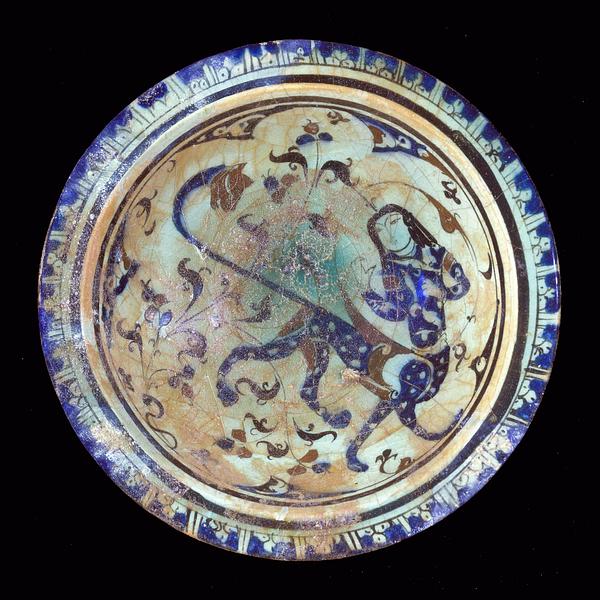Fritware dish, painted in blue, black, and reddish brown under a transparent glaze
Syria, Raqqa; beginning of 13th century
H: 8; Diam: 29.5 cm
At around the same time as Persian potters from Kashan, their Syrian colleagues also began to decorate their wares with the underglaze technique. Although they rarely possessed the same technical perfection as the Persians, much of the Syrians’ pottery did display amazing compositional freedom and self-assurance. This is reflected in the way that the body of the centaur on the dish is balanced elegantly by its own tail, which ends in a menacing animal head.
Centaurs are not common in Islamic art, but there were many references to Classical culture specifically in the province of Jazira – northern Iraq and Syria and southeastern Anatolia.
Inv. no. 54/1966
Published in:
Gönül Öney: “Dragon figures in Anatolian Seljuk art” in Belleten, 1969, 33: 130, p. 210-211, fig. 37;
C .L. Davids Samling. Fjerde Del : Jubilæumsskrift 1945-70, København 1970, cat.no. 13, p. 282;
Adalbert Klein [et al.]: Islamische Keramik, Hetjens-Museum, Düsseldorf 1973, cat.no. 205;
The arts of Islam : Hayward gallery, 8 April - 4 July 1976, London 1976, cat.no. 306;
Art from the World of Islam. 8th-18th century, Louisiana, Humlebæk 1987, cat.no. 85;
Kjeld von Folsach: Islamic art. The David Collection, Copenhagen 1990, cat.no.134;
Kjeld von Folsach: Fabelvæsner fra Islams Verden, Davids Samling, København 1991, cat.no. 14;
Kjeld von Folsach, Torben Lundbæk and Peder Mortensen (eds.): Sultan, Shah and Great Mughal: the history and culture of the Islamic world, The National Museum, Copenhagen 1996, cat.no. 125;
Markus Hattstein and Peter Delius (eds.): Islam: art and architecture, Berlin 2000, p. 197 (picture inverted);
Kjeld von Folsach: Art from the World of Islam in The David Collection, Copenhagen 2001, cat.no. 192;
Eric Delpont (ed.): L'Orient de Saladin: l'art des Ayyoubides: exposition présentée à l'Institut du monde arabe, Paris du 23 octobre 2001 au 10 mars 2002, Institut du monde arabe, Paris 2001, cat.no. 56;
Anne-Marie Keblow Bernsted: Early Islamic pottery: materials and techniques, London 2003, fig. 56, p. 39 and figs. 59-60, p. 40;
Almut v. Gladiss (ed.): Die Dschazira: Kulturlandschaft zwischen Euphrat und Tigris, Museum für Islamische Kunst, Berlin 2006, cat.no. 14, p. 55-56;
Sabiha Al Khemir: Beauty and belief: crossing bridges with the arts of Islamic culture, Brigham Young University Museum of Art, Provo 2012, p. 220;


